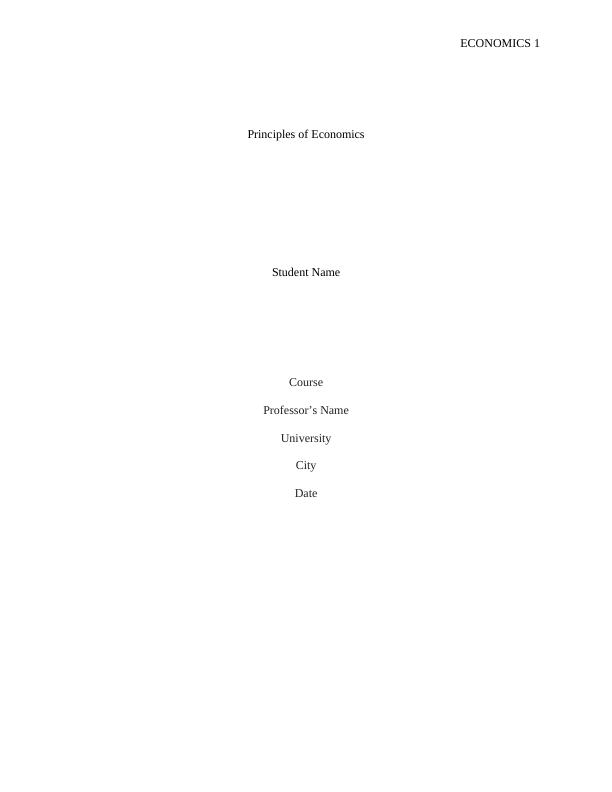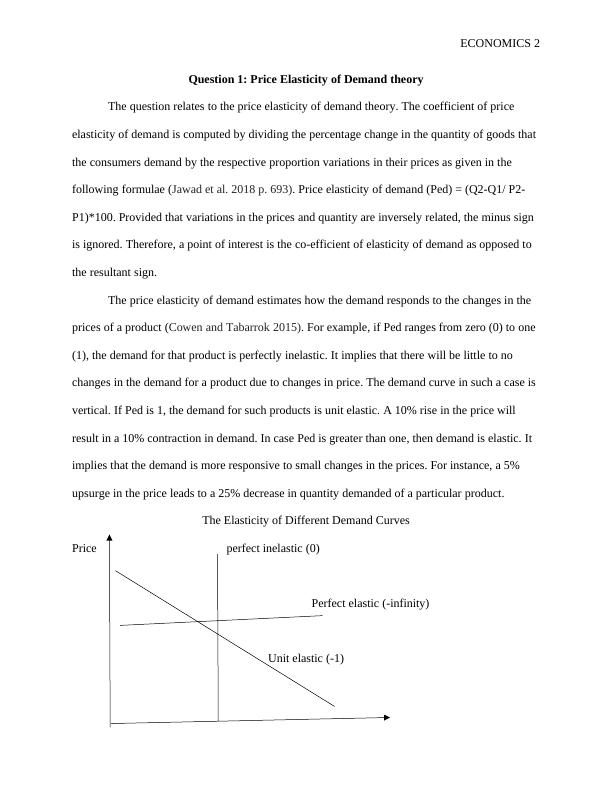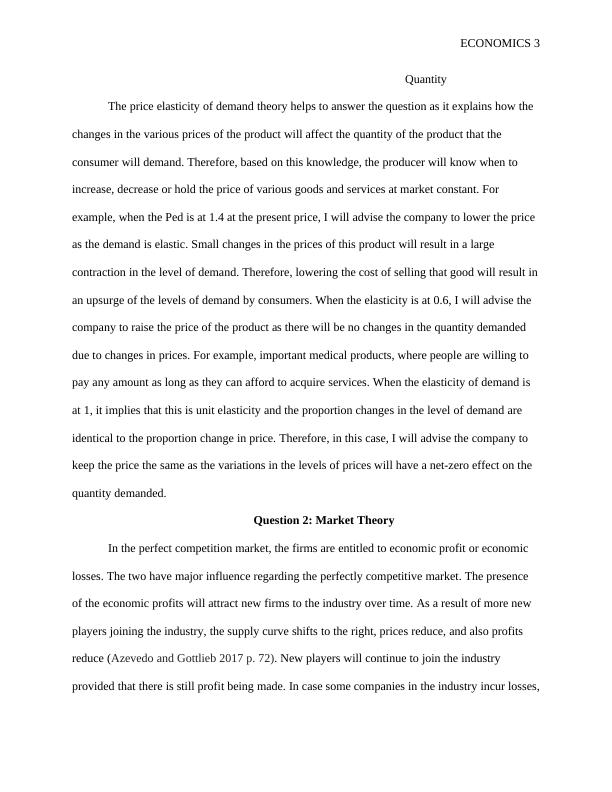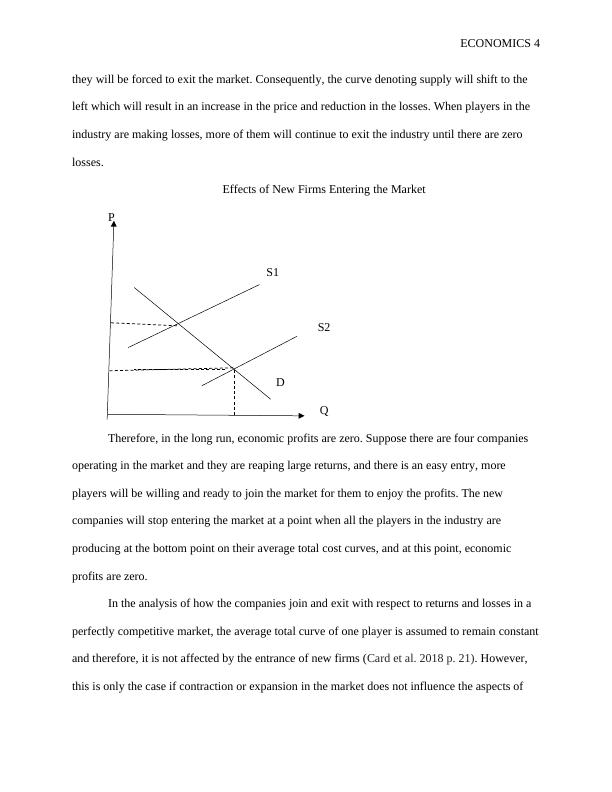Principles of Economics Question Answer 2022
Added on 2022-10-01
11 Pages2948 Words22 Views
ECONOMICS 1
Principles of Economics
Student Name
Course
Professor’s Name
University
City
Date
Principles of Economics
Student Name
Course
Professor’s Name
University
City
Date

ECONOMICS 2
Question 1: Price Elasticity of Demand theory
The question relates to the price elasticity of demand theory. The coefficient of price
elasticity of demand is computed by dividing the percentage change in the quantity of goods that
the consumers demand by the respective proportion variations in their prices as given in the
following formulae (Jawad et al. 2018 p. 693). Price elasticity of demand (Ped) = (Q2-Q1/ P2-
P1)*100. Provided that variations in the prices and quantity are inversely related, the minus sign
is ignored. Therefore, a point of interest is the co-efficient of elasticity of demand as opposed to
the resultant sign.
The price elasticity of demand estimates how the demand responds to the changes in the
prices of a product (Cowen and Tabarrok 2015). For example, if Ped ranges from zero (0) to one
(1), the demand for that product is perfectly inelastic. It implies that there will be little to no
changes in the demand for a product due to changes in price. The demand curve in such a case is
vertical. If Ped is 1, the demand for such products is unit elastic. A 10% rise in the price will
result in a 10% contraction in demand. In case Ped is greater than one, then demand is elastic. It
implies that the demand is more responsive to small changes in the prices. For instance, a 5%
upsurge in the price leads to a 25% decrease in quantity demanded of a particular product.
The Elasticity of Different Demand Curves
Price perfect inelastic (0)
Perfect elastic (-infinity)
Unit elastic (-1)
Question 1: Price Elasticity of Demand theory
The question relates to the price elasticity of demand theory. The coefficient of price
elasticity of demand is computed by dividing the percentage change in the quantity of goods that
the consumers demand by the respective proportion variations in their prices as given in the
following formulae (Jawad et al. 2018 p. 693). Price elasticity of demand (Ped) = (Q2-Q1/ P2-
P1)*100. Provided that variations in the prices and quantity are inversely related, the minus sign
is ignored. Therefore, a point of interest is the co-efficient of elasticity of demand as opposed to
the resultant sign.
The price elasticity of demand estimates how the demand responds to the changes in the
prices of a product (Cowen and Tabarrok 2015). For example, if Ped ranges from zero (0) to one
(1), the demand for that product is perfectly inelastic. It implies that there will be little to no
changes in the demand for a product due to changes in price. The demand curve in such a case is
vertical. If Ped is 1, the demand for such products is unit elastic. A 10% rise in the price will
result in a 10% contraction in demand. In case Ped is greater than one, then demand is elastic. It
implies that the demand is more responsive to small changes in the prices. For instance, a 5%
upsurge in the price leads to a 25% decrease in quantity demanded of a particular product.
The Elasticity of Different Demand Curves
Price perfect inelastic (0)
Perfect elastic (-infinity)
Unit elastic (-1)

ECONOMICS 3
Quantity
The price elasticity of demand theory helps to answer the question as it explains how the
changes in the various prices of the product will affect the quantity of the product that the
consumer will demand. Therefore, based on this knowledge, the producer will know when to
increase, decrease or hold the price of various goods and services at market constant. For
example, when the Ped is at 1.4 at the present price, I will advise the company to lower the price
as the demand is elastic. Small changes in the prices of this product will result in a large
contraction in the level of demand. Therefore, lowering the cost of selling that good will result in
an upsurge of the levels of demand by consumers. When the elasticity is at 0.6, I will advise the
company to raise the price of the product as there will be no changes in the quantity demanded
due to changes in prices. For example, important medical products, where people are willing to
pay any amount as long as they can afford to acquire services. When the elasticity of demand is
at 1, it implies that this is unit elasticity and the proportion changes in the level of demand are
identical to the proportion change in price. Therefore, in this case, I will advise the company to
keep the price the same as the variations in the levels of prices will have a net-zero effect on the
quantity demanded.
Question 2: Market Theory
In the perfect competition market, the firms are entitled to economic profit or economic
losses. The two have major influence regarding the perfectly competitive market. The presence
of the economic profits will attract new firms to the industry over time. As a result of more new
players joining the industry, the supply curve shifts to the right, prices reduce, and also profits
reduce (Azevedo and Gottlieb 2017 p. 72). New players will continue to join the industry
provided that there is still profit being made. In case some companies in the industry incur losses,
Quantity
The price elasticity of demand theory helps to answer the question as it explains how the
changes in the various prices of the product will affect the quantity of the product that the
consumer will demand. Therefore, based on this knowledge, the producer will know when to
increase, decrease or hold the price of various goods and services at market constant. For
example, when the Ped is at 1.4 at the present price, I will advise the company to lower the price
as the demand is elastic. Small changes in the prices of this product will result in a large
contraction in the level of demand. Therefore, lowering the cost of selling that good will result in
an upsurge of the levels of demand by consumers. When the elasticity is at 0.6, I will advise the
company to raise the price of the product as there will be no changes in the quantity demanded
due to changes in prices. For example, important medical products, where people are willing to
pay any amount as long as they can afford to acquire services. When the elasticity of demand is
at 1, it implies that this is unit elasticity and the proportion changes in the level of demand are
identical to the proportion change in price. Therefore, in this case, I will advise the company to
keep the price the same as the variations in the levels of prices will have a net-zero effect on the
quantity demanded.
Question 2: Market Theory
In the perfect competition market, the firms are entitled to economic profit or economic
losses. The two have major influence regarding the perfectly competitive market. The presence
of the economic profits will attract new firms to the industry over time. As a result of more new
players joining the industry, the supply curve shifts to the right, prices reduce, and also profits
reduce (Azevedo and Gottlieb 2017 p. 72). New players will continue to join the industry
provided that there is still profit being made. In case some companies in the industry incur losses,

ECONOMICS 4
they will be forced to exit the market. Consequently, the curve denoting supply will shift to the
left which will result in an increase in the price and reduction in the losses. When players in the
industry are making losses, more of them will continue to exit the industry until there are zero
losses.
Effects of New Firms Entering the Market
P
S1
S2
D
Q
Therefore, in the long run, economic profits are zero. Suppose there are four companies
operating in the market and they are reaping large returns, and there is an easy entry, more
players will be willing and ready to join the market for them to enjoy the profits. The new
companies will stop entering the market at a point when all the players in the industry are
producing at the bottom point on their average total cost curves, and at this point, economic
profits are zero.
In the analysis of how the companies join and exit with respect to returns and losses in a
perfectly competitive market, the average total curve of one player is assumed to remain constant
and therefore, it is not affected by the entrance of new firms (Card et al. 2018 p. 21). However,
this is only the case if contraction or expansion in the market does not influence the aspects of
they will be forced to exit the market. Consequently, the curve denoting supply will shift to the
left which will result in an increase in the price and reduction in the losses. When players in the
industry are making losses, more of them will continue to exit the industry until there are zero
losses.
Effects of New Firms Entering the Market
P
S1
S2
D
Q
Therefore, in the long run, economic profits are zero. Suppose there are four companies
operating in the market and they are reaping large returns, and there is an easy entry, more
players will be willing and ready to join the market for them to enjoy the profits. The new
companies will stop entering the market at a point when all the players in the industry are
producing at the bottom point on their average total cost curves, and at this point, economic
profits are zero.
In the analysis of how the companies join and exit with respect to returns and losses in a
perfectly competitive market, the average total curve of one player is assumed to remain constant
and therefore, it is not affected by the entrance of new firms (Card et al. 2018 p. 21). However,
this is only the case if contraction or expansion in the market does not influence the aspects of

End of preview
Want to access all the pages? Upload your documents or become a member.
Related Documents
ECON 1102 - Macroeconomics - Increase in Demandlg...
|10
|2413
|34
Elasticities in Economics and Commercial Banks' Money Creationlg...
|11
|3369
|360
Principles of Economicslg...
|13
|2766
|54
Assignment | The same as the quantity that consumers are willing and ready to purchase.lg...
|5
|736
|15
Factors Affecting Price Elasticity of Demandlg...
|12
|2791
|209
Price Elasticity of Demand & Monopoly Market Structure Questionslg...
|16
|3419
|85